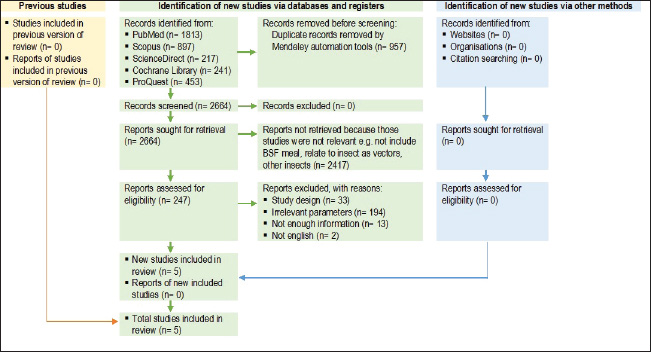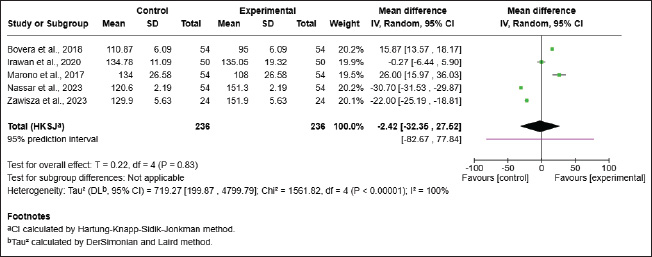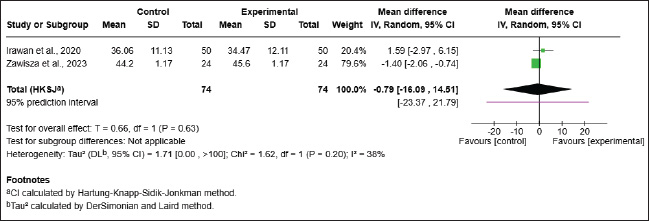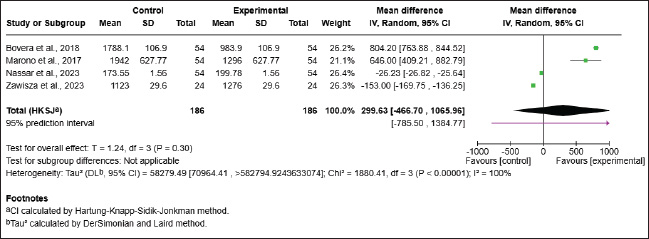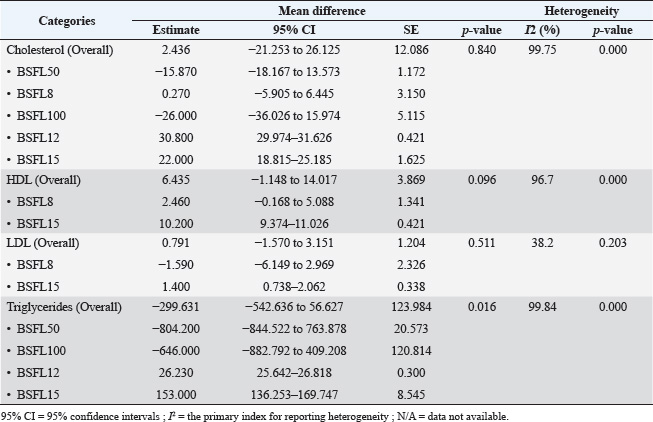
| Research Article | ||
Open Vet. J.. 2025; 15(8): 3580-3589 Open Veterinary Journal, (2025), Vol. 15(8): 3580-3589 Research Article The impact of feeding black soldier fly larvae on the blood lipid profile of laying hens: A meta-analysisMuhammad Thohawi Elziyad Purnama1,2*, Faisal Fikri1,2 and Hakan Çalışkan31Division of Veterinary Medicine, Department of Health and Life Sciences, Faculty of Health, Medicine, and Life Sciences, Universitas Airlangga, Banyuwangi, Indonesia 2Research Group of Animal Biomedical and Conservation, Faculty of Health, Medicine, and Life Sciences, Universitas Airlangga, Banyuwangi, Indonesia 3Department of Biology, Faculty of Science, Eskişehir Osmangazi Üniversitesi, Eskişehir, Türkiye *Corresponding Author: Muhammad Thohawi Elziyad Purnama. Division of Veterinary Medicine, Department of Health and Life Sciences, Faculty of Health, Medicine, and Life Sciences, Universitas Airlangga, Banyuwangi, Indonesia. Email: thohawi [at] fkh.unair.ac.id Submitted: 09/05/2025 Revised: 29/06/2025 Accepted: 09/07/2025 Published: 31/08/2025 © 2025 Open Veterinary Journal
ABSTRACTBackground: The black soldier fly (BSF), Hermetia illucens, has been widely investigated as an alternative protein source to soy and fish meal in laying hen diets. However, the fatty acid profile of BSF may influence chicken performance, egg production, and blood lipid levels, with inconsistent results reported. Aim: To resolve conflicting findings, this meta-analysis aimed to synthesize existing studies that indicate the effects of black soldier fly larvae (BSFL) meal on the blood lipid profile levels of laying hens. Methods: Five databases (PubMed, Scopus, ProQuest, Science Direct, and Cochrane Library) were searched using the keywords H. illucens, BSF, laying hens, and lipid profile. Study selection followed the preferredreportingiPreferred Reporting Items for systematicrSystematic Reviews and meta-analysiMeta-Analyses 2020 guidelines. All extracted data were calculated applying online software Review Manager (RevMan) (Cochrane Collaboration, UK) to estimate random effects, mean differences (MD), heterogeneity (I²), subgroup analysis, and visualize forest and Funnel plots. Results: A total of five eligible investigations were retrieved in the quantitative meta-analysis to comprehensively evaluate the efficacy of BSFL meal on cholesterol, high-density lipoprotein (HDL), low-density lipoprotein (LDL), and triglycerides in laying hens. All of the following parameters were not significantly altered by BSFL inclusion: cholesterol (MD=−2.42, 95% CI: −32.35 to 27.52, p=0.83), HDL (MD=−6.43, 95% CI: −55.59 to 42.72, p=0.34), LDL (MD=−0.79, 95% CI: −16.09 to 14.51, p=0.63), and triglycerides (MD=299.63, 95% CI: −466.70 to 1,065.96, p=0.30). According to the subgroup analysis, modifications in the BSFL meal ratio may only affect triglycerides; cholesterol, HDL, and LDL were not significant. Conclusion: According to this meta-analysis, BSFL meal represents a promising feed substitute for laying hens that has no detrimental effects on cholesterol, HDL, LDL, and triglyceride levels. Keywords: Black soldier fly, Blood lipid profile, Food production, Food safety, Meta-analysis. IntroductionEggs are a staple food that includes nutrients that have important functions beyond basic nutrients, and they are a vital source of animal protein. Biactive substances present in eggs, including proteins, lutein, zeaxanthin, cholesterol, and phospholipids, ameliorate the pathophysiology of several chronic diseases. These substances have pro- and anti-inflammatory qualities (Alexander et al., 2016). Eggs are an essential contributor to dietary cholesterol because a single egg has around 186 mg of cholesterol (Miranda et al., 2015). Protein, essential fatty acid chains, antioxidant-rich substances, choline, vitamins, and minerals are all found in eggs, which are a nutrient-dense, complete food. As such, their overall nutritional value should be considered rather than their components, such as cholesterol (Clayton et al., 2017). In less than 20 years, global egg output has increased by more than 50%, and considering soybeans contain high metabolisable energy properties and a desired amino acid profile, they are now the primary protein source in the diets of the majority of commercial laying hens (Mottet and Tempio, 2017; Berlina et al., 2023). Because current studies are focused on more sustainable protein sources than soybeans that do not interfere with the production of human food, insects are a viable substitute due to their remarkable potential. The black soldier fly larvae (BSFL) (Hermetia illucens L.) in particular show promise due to their beneficial crude protein properties (380–460 g/kg DM), gross energy content (5,378–6,071 kcal/kg DM), favourable amino acid profile, and ability to be raised on a variety of substrates, including food sector byproducts (Heuel et al., 2021). Lauric (C12:0) and myristic (C14:0) acids are more prevalent in the saturated fatty acids (SFAs) in BSFL than in other insect species, including yellow mealworms, house crickets, and cockroaches. In monogastric animals, lauric acid has antibacterial actions (Anzaku et al., 2017). Given that it has no detrimental effects on intestinal morphology or blood parameters, BSFL also offers potential as an essential lipid in broiler diets (Abd El-Hack et al., 2020; Fuddin et al., 2022). The effectiveness of BSFL on laying hen production and egg quality has been assessed in earlier research. Nutrient composition and cholesterol levels in eggs were all unaffected by BSFL meal (Irawan et al., 2019; Nassar et al., 2023; Zawisza et al., 2023). In other studies, BSFL meal considerably ameliorates the levels of TG and cholesterol (Marono et al., 2017; Bovera et al., 2018). The implementation of a meta-analysis study aimed to collectively analyze and collate studies that demonstrate the effects of BSFL meal on the blood lipid profile levels of laying hens due to inconsistent results that may arise in individual investigations. Materials and MethodsStudy selectionThe meta-analysis adhered to the principles of the preferredreportingiPreferred Reporting Items for Systematic Reviews and Meta-Analysis (PRISMA) statement (Page et al., 2021). The search was conducted by two independent reviewers, that is F.F. at the library of Universitas Airlangga, Indonesia, and MTEP at Eskişehir Osmangazi Üniversitesi, Türkiye, under subscription access to PubMed, Scopus, ProQuest, Science Direct, and Cochrane Library repositories and databases. The relevant literature search period was conducted from June 12, 2024 to December 20, 2025. The “Topic” field and the “Title-Abstract-Keywords” field in repositories were searched using a mix of advanced search phrases and Boolean keywords operators associated with “Hermetia illucens, black soldier fly, laying hens, and lipid profile” that is #1 chicken [MeSH Terms] OR hens [Title/Abstract] OR layer [Title/Abstract] OR laying hens [Title/Abstract] #2 black soldier fly [MeSH Terms] OR Hermetia illucens [Title/Abstract] OR maggot [Title/Abstract] #3 egg quality [MeSH Terms] AND production performance [MeSH Terms] OR growth performance [Title/Abstract] OR lipid profile [Title/Abstract]. Eligibility criteriaThe process involving selecting investigations for the meta-analysis is illustrated in Figure 1. The included studies were experimental designs involving control groups and those fed black soldier fly (BSF) feed products, as well as control diets that included BSF feed or a protein source replaced by BSF and at least one of the following parameters for laying hens, that is, cholesterol, high-density lipoprotein (HDL), low-density lipoprotein (LDL), and triglycerides. Only studies reporting mean values for these parameters were included. The evaluation also took into account the BSF growth phase, BSF dietary inclusion level, feeding duration, and the replication size, SD, or SE, which were shown numerically or visually for the respective parameter. Conference proceedings, reviews, irrelevant study designs, non-experimental studies, and duplicate reports were not included. The relevant BSF diet was compared independently with each control group if the study had multiple diet groups and gradual ratio modifications. In order to facilitate multiple comparisons, studies that included more than two treatments were categorised separately. Files were exported from each database in text and CSV formats, and references and duplicates were managed using Mendeley (version 1.19.5). Titles and abstracts were separately examined for relevance to the research topic after duplicates were eliminated. Although there were no initial language constraints, the final analysis only included papers that were published in English. There was no year limit used to select the literature. Every qualifying paper was put through a quality evaluation checklist that assessed methodological rigour, applying the Joanna Briggs Institute’s (JBI) criteria (Porritt et al., 2014). The sub-items’ scale was transformed into percents, and the maximum, minimum, and median values were assessed. For the respective sub-items, the number of studies rated as “Yes,” “No,” “Unclear,” and “Not applicable” was looked at: (i) the research objective clearly described and stated, (ii) the period and location of the study clearly stated, (iii) the sample categorized into different subgroups, (iv) the sampling method described in detail, and (v) the parameters pointed out. Data extractionData were extracted on (1) study references; (2) study period; (3) country; (4) laying hen breed; (5) BSFL treatment ratio; (6) age of laying hens; and (7) sample size. In-depth information about the results was also retrieved, including the sample sizes for the treatment and control groups as well as the levels of triglycerides, HDL, LDL, and cholesterol. Data discrepancies were settled by author consensus, considering cross-referenced information and study limitations. The extracted data was assembled in a methodical manner for tabulation and analysis in Microsoft Excel (Microsoft Corporation, Redmond, WA 98052-6399) (Table 1). Statistical analysisThe extracted data were assumed as “continuous” and sample size assumed as “categorize” data, then calculated using the online version of Review Manager (RevMan) (Cochrane Collaboration, UK) to visualise the forest and funnel plots, compute the mean difference (MD), random effect, and 95% CI, as well as to perform subgroup analysis. Random-effects models used tau-squared (τ²), a measure of study variance. It assesses the degree of heterogeneity in meta-analysis directly using the effect measure scale. One way to measure the level of heterogeneity in a meta-analysis is to interpret the index for reporting heterogeneity (I²). Studies have demonstrated that alternative approaches to estimate the between-study variance outperform the DerSimonian and Laird moment-based method, although the computations are simple. Analysis of asymmetry in funnel plots was implemented to assess publication bias. Heterogeneity was assumed significant when the corresponding p-value was less than 0.05 and the I² statistic degree was greater than 50%.
Fig. 1. PRISMA flow diagram for selecting eligible studies. Table 1. Characteristics of the studies included in the meta-analysis.
Ethical approvalThis meta-analysis study did not involve any animals, so ethical approval was not required. The literature search procedure has followed the PRISMA flowchart standard and is openly registered in the Open Science Framework (https://osf.io/ckpgs/). ResultsSelection and inclusion of eligible studiesA comprehensive literature search was conducted across five major databases: PubMed (n=1813), Scopus (n=897), ScienceDirect (n=217), Cochrane Library (n=241), and ProQuest (n=453), focusing on studies addressing blood lipid profiles in laying hens fed BSFL meal. Duplicate records (n=957) were automatically removed using Mendeley software. Of the remaining 2,664 studies screened by abstract, 2,417 were excluded due to irrelevance, lack of evaluation of BSFL meal, focus on other insects as vectors, or association with pathogens. A total of 247 full-text articles were assessed for eligibility, from which 242 were excluded due to irrelevant study design (n=33), irrelevant outcome parameters (n=194), insufficient information (n=13), or language other than English (n=2). Ultimately, five studies met the inclusion criteria and were included in the quantitative meta-analysis (Fig. 1). Characteristics of the eligible studiesThe five included studies comprised a total of 836 laying hens, distributed among Hy-Line Brown (n=432), ISA Brown (n=200), Lohmann Brown Classic (n=108), and Bovans Brown (n=96) strains. The dietary BSFL meal inclusion levels varied across studies, ranging from 0% up to 100%, with specific ratios including 8%, 12%, 15%, and 50%. The duration of BSFL meal feeding during the laying phase ranged from 8 to 21 weeks (Table 1). Study quality assessmentThe quality assessment scores for the five included studies were rated as “Yes” for study rates with a maximum of 100%, a minimum of 0%, and a median of 50% based on the JBI critical appraisal checklist. There was no maximum, minimum, or median for the studies that were categorised as “No”, “Unclear”, and “Not applicable”. Therefore, all included studies had information that was highly eligible for data extraction and inclusion in the meta-analysis (Table 2). Meta-analysis and subgroup analysisThis meta-analysis demonstrated that the BSFL meal had no detrimental effects on all of the following lipid profile variables: cholesterol (MD=−2.42, 95% CI: −32.35 to 27.52, p=0.83) (Fig. 2), HDL (MD=−6.43, 95% CI: −55.59 to 42.72, p=0.34) (Fig. 3), LDL (MD=−0.79, 95% CI: −16.09 to 14.51, p=0.63) (Fig. 4), and triglycerides (MD=299.63, 95% CI: −466.70 to 1,065.96, p=0.30) (Fig. 5). The BSFL meal as a whole can be applied as laying hen feed without impacting changes in cholesterol, HDL, LDL, and triglyceride levels. This is additionally confirmed by the index for reporting heterogeneity (I²), demonstrating low levels of data heterogeneity at LDL (I²=38%, p=0.20) levels but substantial variations at cholesterol (I²=100%, p < 0.00001), HDL (I²=97%, p < 0.00001), and triglycerides (I²=100%, p < 0.00001). According to subgroup analysis, variations in BSFL meal ratios were not significantly affecting cholesterol (p=0.840), HDL (p=0.096), or LDL (p=0.511) levels. However, triglyceride levels were significantly (p=0.016) impacted by BSFL meal modifications. Triglycerides were shown to be lowered by a BSFL50% meal ratio (MD=−804.200, 95% CI: −844.522 to 763.878) and raised by a BSFL15% meal ratio (MD=153.000, 95% CI: 136.253 to 169.747) (Table 3). Risk of publication biasThe funnel plot represents a symmetrical distribution of study points, indicating a minimal risk of publication bias. However, the small number of eligible studies may limit the power of this assessment and could influence the distribution of points in the funnel plot (Fig. 6). DiscussionThe meta-analysis revealed that the data were diverse, as each parameter had an I² value higher than 50%. To handle the uncertainty in assessing between-study heterogeneity, a random-effects model was utilised, which included tau-squared (τ²) and the DerSimonian and Laird moment. The findings demonstrated that incorporating BSFL meal as a feed alternative had no cumulative impact on levels of cholesterol, HDL, LDL, or triglycerides. According to earlier research, BSFL meal had no discernible effect on cholesterol (Bovera et al., 2018). Consistent cholesterol and triglyceride levels indicate that BSFL meal applies harmoniously for laying hens as a feed alternative. It is assumed that the chitin concentration of BSFL is responsible for the scarcity of noticeable increases in cholesterol levels. Chitin decreased gastrointestinal absorption of lipids by adhering to fatty acids and lipids directly or by adhering to fatty acids and bile acids, and lowering plasma cholesterol (El-Gobary et al., 2016). Chitin could reduce cholesterol and triglycerides due to its beneficial charge, which can attract negatively polarised bile acids and free fatty acids (Islam et al., 2022). In another investigation, increased cholesterol was reported in a study involving a 75% BSFL meal ratio in broiler chickens (Srikha et al., 2024). The substantial levels of lauric acid in BSFL are responsible for the cholesterol elevation (Chandra et al., 2022). It is widely acknowledged that hens with higher levels of medium-chain fatty acids (MCFAs) have lower total cholesterol than those with higher levels of long-chain fats (Wang et al., 2015; Khatibjoo et al., 2018). The ratio of the food’s MCFAs to long-chain SFAs is necessary for the latter to possess an advantageous hypocholesterolemic effect (Kumar et al., 2021; Agustono et al., 2024). Additionally, as BSFL has a higher cholesterol content than fishmeal, the cholesterol content of carcasses from hens fed BSFL meal would also be impacted by dietary cholesterol levels (Priyadarshana et al., 2021). Table 2. Study quality assessment of the included studies in each category that adopted the JBI critical appraisal checklist.
Fig. 2. Forest plot based on MD and 95% confidence interval, reporting the random-effect for cholesterol.
Fig. 3. Forest plot based on MD and 95% confidence interval, reporting the random-effect for HDL.
Fig. 4. Forest plot based on MD and 95% confidence interval, reporting the random-effect for LDL.
Fig. 5. Forest plot based on MD and 95% confidence interval, reporting the random-effect for triglycerides. Table 3. Subgroup analysis of the effects of BSFL meal on each parameter.
Increased apolipoprotein A1 (ApoA1) secretion following MCFA administration was associated with an elevation in HDL level (Popeijus et al., 2021). The main protein found in HDL particles, ApoA1, is essential for regulating HDL concentration. The major organ responsible for ApoA1 synthesis and excretion is the liver, which produces 70% of the protein. Maintaining appropriate blood levels of ApoA1, which is essential for controlling HDL concentration and cholesterol metabolism, depends on this hepatic activity (Agustono et al., 2019; Fuior and Gafencu, 2019). These findings are in line with Marono et al. (2017), Bovera et al. (2018), and Irawan et al. (2020) in individual investigations, which showed that feeding BSFL increased plasma total cholesterol, LDL, and triglyceride levels.
Fig. 6. Funnel plot of data distribution based on MD and SE for each parameter: (a) cholesterol; (b) HDL; (c) LDL; and (d) triglycerides. Subgroup analyses demonstrated that fluctuations in triglyceride levels were moderated by BSFL meal ratio variations of 15%–50%. Excess fatty acids are transformed into triglycerides for storage and transportation, which is the reason for excessive triglyceride levels. Endogenous lipid metabolism, which includes fatty acid synthesis, oxidation, lipid export, and lipogenesis activities that exist in the liver, is an essential pathway for regulating the deposition of triglycerides in the liver (Sugiharto and Raza, 2024; Titisari et al., 2025). Triglycerides contain esterified fatty acids in the sn-2 position, which is an important dietary component. It is the fatty acids esterified in 2-monoglycerides that are primarily absorbed in the duodenum (Serra et al., 2018). The primary method for obtaining them is lipolysis, which is caused by the hydrolysis of fatty acids esterified in the α-position by pancreatic lipase. Intestinal villi are better at absorbing fatty acids esterified at the β-position (Tognocchi et al., 2023). Triglyceride synthesis is triggered by three enzymes: glycerol-3-phosphate acyl-transferase converts fatty acids into sn-1, lyso-phosphatidic acid acyl-transferase converts them into sn-2, and diacylglycerol acyl-transferase converts them into sn-3, completing the synthesis of triglycerides. Because fatty acids have varying affinities for various enzymes, the fatty acid properties of the triglyceride sites vary as well (Fikri et al., 2024). LDL and chylomicrons are distributed via the circulatory system to hydrolyse triglycerides and metabolise lipids via the contribution of lipoprotein lipases (Faiqoh et al., 2023). Additionally, cellular tissues are capable of absorbing free fatty acids from LDL and chylomicrons for oxidation or retention (Lestari et al., 2021; Hardiansyah and Lamid, 2022). From our perspective, the limitation of this study is due to the involvement of only five studies, which allows for a low risk of bias. In addition, previous studies generally investigated the parameters of growth performance and production of laying hens, so the lack of studies involving blood lipid parameters investigated in BSFL feed efficacy studies in laying hens is also an opportunity to be explored further for future studies. Moreover, not only larvae, prepupa phase of BSFL and feeding duration up to 8 weeks of the study period can also be considered to accurately evaluate the efficacy on blood lipid profile in laying hens. ConclusionThe inclusion of BSFL meal in laying hen diets does not significantly affect lipid profile parameters, indicating its potential as a safe alternative protein source. As well, triglyceride level variations were found to be impacted by BSFL meal modifications with a ratio of 15%–50%; however, cholesterol, HDL, and LDL levels were not significantly affected. AcknowledgmentsThe authors would like to thank the Dean of the Faculty of Health, Medicine, and Life Science, Universitas Airlangga, Indonesia, and the Dean of the Faculty of Science, Eskişehir Osmangazi Üniversitesi, Türkiye, for facilitating access to repositories, libraries, and subscriptions to adequate literature for this study. Conflict of interestThe authors declare that they have no competing interests. FundingThere is no funding in this study. Authors contributionMTEP contributed to conceptualizing the study methodology. FF, HÇ, and MTEP contributed to selecting, evaluating, extracting data, and curating data. MTEP performed statistical analysis and visualized tables and figures. HÇ and MTEP drafted and revised the manuscript. All authors contributed to and approved the submission of the manuscript. Data availabilityAll data are provided in the manuscript. ReferencesAbd El-Hack, M.E., Shafi, M.E., Alghamdi, W.Y., Abdelnour, S.A., Shehata, A.M., Noreldin, A.E. and Ragni, M. 2020. Black soldier fly (Hermetia illucens) meal as a promising feed ingredient for poultry: a comprehensive review. Agriculture 10(8), 339. Agustono, B., AbidahAlfirdausy, S., Warsito, S.H., Yunita, M.N., Lokapirnasari, W.P., Purnama, M.T.E. and Rahman, M.A. 2024. Influence of Mauritia flexuosa L. on broiler carcass mass and digestive organs temperature-exposed body mass. Indian Vet. J. 101(2), 10–14. Agustono, B., Al Arif, M.A., Yunita, M.N., Purnama, M.T.E. and Ulkhaq, F. 2019. Bioactivity of digestive enzymes and histological descriptions of jejunum of broilers supplemented with sunflower seed flour (Helianthus annuus L). Indian Vet. J. 96(8), 12–15. Alexander, D.D., Miller, P.E., Vargas, A.J., Weed, D.L. and Cohen, S.S. 2016. Meta-analysis of egg consumption and risk of coronary heart disease and stroke. J. Am. College Nutr. 35(8), 704–716. Anzaku, A.A., Akyala, J.I., Juliet, A. and Obianuju, E.C. 2017. Antibacterial activity of lauric acid on some selected clinical isolates. Ann. Clin. Lab. Res. 5(2), 1–5. Berlina, C.R., Hidanah, S., Al Arif, M.A., Luqman, E.M. and Yuniarti, W.M. 2023. Efficacy of lactic acid bacteria probiotics on feed efficiency and carcass weight in Kampung Unggul Balitbangtan (KUB) chicken. J. Med. Vet. 6(3), 427–432. Bovera, F., Loponte, R., Pero, M.E., Cutrignelli, M.I., Calabrò, S., Musco, N., Vassalotti, G., Panettieri, V., Lombardi, P., Piccolo, G., Di Meo, C., Siddi, G., Fliegerova, K. and Moniello, G. 2018. Laying performance, blood profiles, nutrient digestibility and inner organs traits of hens fed an insect meal from Hermetia illucens larvae. Res. Vet. Sci. 120, 86–93. Chandra, E.H., Lokapirnasari, W.P., Hidanah, S., Al-Arif, M.A., Yuniarti, W.M. and Luqman, E.M. 2022. Probiotic potential of lactic acid bacteria on feed efficiency, weight and carcass percentage in ducks. J. Med. Vet. 5(1), 69–73. Clayton, Z.S., Fusco, E. and Kern, M. 2017. Egg consumption and heart health: a review. Nutrition 37, 79–85. El-Gobary, G., El-Zoghby, A.F., El-Sheikh, N. and Hamdy, A.S. 2016. Effect of chito-oligosaccharide as feed additives on egg production and performance of laying hens. Egypt. J. Chem. Environ. Health 2(2), 183–194. Faiqoh, B.E., Lamid, M., Damayanti, R., Chusniati, S., Al Arif, M.A., Warsito, S.H. and Hussain, M.A. 2023. Effect of probiotic administration of Bacillus subtilis and Bacillus coagulans isolate on growth performance in broiler chicken. J. Med. Vet. 6(3), 410–417. Fikri, F., Purnomo, A., Chhetri, S., Purnama, M.T.E. and Çalışkan, H. 2024. Effects of black soldier fly (Hermetia illucens) larvae meal on production performance, egg quality, and physiological properties in laying hens: a meta-analysis. Vet. World 17(8), 1904–1913. Fuddin, M.N., Lamid, M., Al Arif, M.A., Lokapirnasari, W.P., Hidanah, S. and Sarmanu, S. 2022. Maggot black soldier fly supplementation on feed to production performance and business analysis super native chicken finisher period. J. Med. Vet. 5(2), 234–240. Fuior, E.V. and Gafencu, A.V. 2019. Apolipoprotein C1: its pleiotropic effects in lipid metabolism and beyond. Int. J. Mol. Sci. 20(23), 5939. Hardiansyah, R. and Lamid, M. 2022. An efficacy of seligi leaf flour fermentation on cholesterol levels, low density lipoprotein, and high density lipoprotein in catfish. J. Med. Vet. 5(1), 41–47. Heuel, M., Sandrock, C., Leiber, F., Mathys, A., Gold, M., Zurbrügg, C., Gangnat, I.D.M., Kreuzer, M. and Terranova, M. 2021. Black soldier fly larvae meal and fat can completely replace soybean cake and oil in diets for laying hens. Poult. Sci. 100(4), 101034. Irawan, A.C., Astuti, D.A., Wibawan, I.W.T., Hermana, W. and Hermana, W. 2020. Supplementation of black soldier fly (Hermetia illucens) on productivity and blood hematology. J. Ilmu-Ilmu Peternakan. 30(1), 50–68. Irawan, A.C., Astuti, D.A., Wibawan, I.W.T. and Hermana, W. 2019. Impact of the feeding with the black soldier fly (Hermetia illucens) on egg physical quality, egg chemical quality and lipid metabolism of laying hens. IOP Publishing J. Phys. Conf. Ser. 1351(1), 012081. Islam, M.S., Sharif, A., Kwan, N. and Tam, K.C. 2022. Bile acid sequestrants for hypercholesterolemia treatment using sustainable biopolymers: recent advances and future perspectives. Mol. Pharm. 19(5), 1248–1272. Khatibjoo, A., Mahmoodi, M., Fattahnia, F., Akbari-Gharaei, M., Shokri, A.N. and Soltani, S. 2018. Effects of dietary short-and medium-chain fatty acids on performance, carcass traits, jejunum morphology, and serum parameters of broiler chickens. J. Appl. Anim. Res. 46(1), 492–498. Kumar, F., Tyagi, P.K., Mir, N.A., Dev, K., Begum, J., Tyagi, P.K. and Sharma, D. 2021. Growth pattern, lipid composition, oxidation status, and serum biochemical profile of broiler chicken fed flaxseed meal for different durations: flaxseed meal in broiler chicken nutrition. Lett. Anim. Biol. 1(1), 08–18. Lestari, R.D., Lokapirnasari, W.P., Al Arif, M.A., Hidanah, S., Soeharsono, S. and Lamid, M. 2021. The effect of additional feed fermentation of Moringa oleifera leaves on the cholesterol level of Mojosari laying ducks. J. Med. Vet. 4(2), 221–225. Marono, S., Loponte, R., Lombardi, P., Vassalotti, G., Pero, M.E., Russo, F., Gasco, L., Parisi, G., Piccolo, G., Nizza, S., Di Meo, C., Attia, Y.A. and Bovera, F. 2017. Productive performance and blood profiles of laying hens fed Hermetia illucens larvae meal as total replacement of soybean meal from 24 to 45 weeks of age. Poult. Sci. 96(6), 1783–1790. Miranda, J.M., Anton, X., Redondo-Valbuena, C., Roca-Saavedra, P., Rodriguez, J.A., Lamas, A., Franco, C.M. and Cepeda, A. 2015. Egg and egg-derived foods: effects on human health and use as functional foods. Nutrition 7(1), 706–729. Mottet, A. and Tempio, G. 2017. Global poultry production: current state and future outlook and challenges. World Poult. Sci. J. 73(2), 245–256. Nassar, F.S., Alsahlawi, A.M., Abbas, A.O., Alaqil, A.A., Kamel, N.N. and Abdelwahab, A.M. 2023. Impact of dietary inclusion of black soldier fly larvae (Hermetia illucens) as a replacement for soybean-corn ingredients on egg production, physiological status, and economic efficiency of laying hens. Adv. Anim. Vet. Sci. 11(2), 295–304. Page, M.J., McKenzie, J.E., Bossuyt, P.M., Boutron, I., Hoffmann, T.C., Mulrow, C.D., Shamseer, L., Tetzlaff, J.M., Akl, E.A., Brennan, S.E., Chou, R., Glanville, J., Grimshaw, J.M., Hróbjartsson, A., Lalu, M.M., Li, T., Loder, E.W., Mayo-Wilson, E., McDonald, S., McGuinness, L.A., Stewart, L.A., Thomas, J., Tricco, A.C., Welch, V.A., Whiting, P. and Moher, D. 2021. The PRISMA 2020 statement: an updated guideline for reporting systematic reviews. BMJ 372(71), n71. Popeijus, H.E., Zwaan, W., Tayyeb, J.Z. and Plat, J. 2021. Potential contribution of short chain fatty acids to hepatic apolipoprotein AI production. Int. J. Mol. Sci. 22(11), 5986. Porritt, K., Gomersall, J. and Lockwood, C. 2014. JBI’s systematic reviews: study selection and critical appraisal. AJN Am. J. Nurs. 114(6), 47–52. Priyadarshana, M.K.C., Walpita, C.N., Naveenan, M., Magamage, M.P.S. and Ruwandeepika, H.A.D. 2021. Substitution of fishmeal with black soldier fly Hermetia illucens linnaeus, 1758 larvae in finfish aquaculture-a review. Asian Fish. Sci. 34(2), 114–126. Serra, A., Conte, G., Ciucci, F., Bulleri, E., Corrales-Retana, L., Cappucci, A. and Mele, M. 2018. Dietary linseed supplementation affects the fatty acid composition of the sn-2 position of triglycerides in sheep milk. J. Dairy Sci. 101(8), 6742–6751. Srikha, T., Pootthachaya, P., Puangsap, W., Pintaphrom, N., Somparn, N., Boonkum, W. and Wongtangtintharn, S. 2024. Effects of black soldier fly larvae oil on growth performance, blood biochemical parameters, carcass quality, and metabolomics profile of breast muscle of Thai native chickens. Animals 14(21), 3098. Sugiharto, S. and Raza, M.A. 2024. Optimization of poultry physiological condition in the post-antibiotic era through nutritional intervention–a review. J. Med. Vet. 7(2), 388–406. Titisari, N., Ahmad, H., Fauzi, A., Samsulrizal, N. and Abdul Razak, I.S. 2025. Potential effects of omega-3 fatty acids on type 1 diabetes in preventing Alzheimer’s disease progression. J. Med. Vet. 8(1), 223–235. Tognocchi, M., Conte, G., Rossi, E., Perioli, R., Mantino, A., Serra, A. and Mele, M. 2023. Characterization of polar and non-polar lipids of Hermetia illucens and Tenebrio molitor meals as animal feed ingredients. Anim. Feed Sci. Technol. 295, 115524. Wang, J., Wang, X., Li, J., Chen, Y., Yang, W. and Zhang, L. 2015. Effects of dietary coconut oil as a medium-chain fatty acid source on performance, carcass composition and serum lipids in male broilers. Asian-Australas. J. Anim. Sci. 28(2), 223. Zawisza, P., Szymczyk, B., Arczewska-Włosek, A. and Szczepanik, K. 2023. Effects of partial replacement of soybean meal with defatted Hermetia illucens meal in the diet of laying hens on performance, dietary egg quality, and serum biochemical and redox indices. Animals 13(3), 527. | ||
| How to Cite this Article |
| Pubmed Style Purnama MTE, Fikri F, Calışkan H. The impact of feeding black soldier fly larvae on the blood lipid profile of laying hens: A meta-analysis. Open Vet. J.. 2025; 15(8): 3580-3589. doi:10.5455/OVJ.2025.v15.i8.20 Web Style Purnama MTE, Fikri F, Calışkan H. The impact of feeding black soldier fly larvae on the blood lipid profile of laying hens: A meta-analysis. https://www.openveterinaryjournal.com/?mno=257209 [Access: December 08, 2025]. doi:10.5455/OVJ.2025.v15.i8.20 AMA (American Medical Association) Style Purnama MTE, Fikri F, Calışkan H. The impact of feeding black soldier fly larvae on the blood lipid profile of laying hens: A meta-analysis. Open Vet. J.. 2025; 15(8): 3580-3589. doi:10.5455/OVJ.2025.v15.i8.20 Vancouver/ICMJE Style Purnama MTE, Fikri F, Calışkan H. The impact of feeding black soldier fly larvae on the blood lipid profile of laying hens: A meta-analysis. Open Vet. J.. (2025), [cited December 08, 2025]; 15(8): 3580-3589. doi:10.5455/OVJ.2025.v15.i8.20 Harvard Style Purnama, M. T. E., Fikri, . F. & Calışkan, . H. (2025) The impact of feeding black soldier fly larvae on the blood lipid profile of laying hens: A meta-analysis. Open Vet. J., 15 (8), 3580-3589. doi:10.5455/OVJ.2025.v15.i8.20 Turabian Style Purnama, Muhammad Thohawi Elziyad, Faisal Fikri, and Hakan Calışkan. 2025. The impact of feeding black soldier fly larvae on the blood lipid profile of laying hens: A meta-analysis. Open Veterinary Journal, 15 (8), 3580-3589. doi:10.5455/OVJ.2025.v15.i8.20 Chicago Style Purnama, Muhammad Thohawi Elziyad, Faisal Fikri, and Hakan Calışkan. "The impact of feeding black soldier fly larvae on the blood lipid profile of laying hens: A meta-analysis." Open Veterinary Journal 15 (2025), 3580-3589. doi:10.5455/OVJ.2025.v15.i8.20 MLA (The Modern Language Association) Style Purnama, Muhammad Thohawi Elziyad, Faisal Fikri, and Hakan Calışkan. "The impact of feeding black soldier fly larvae on the blood lipid profile of laying hens: A meta-analysis." Open Veterinary Journal 15.8 (2025), 3580-3589. Print. doi:10.5455/OVJ.2025.v15.i8.20 APA (American Psychological Association) Style Purnama, M. T. E., Fikri, . F. & Calışkan, . H. (2025) The impact of feeding black soldier fly larvae on the blood lipid profile of laying hens: A meta-analysis. Open Veterinary Journal, 15 (8), 3580-3589. doi:10.5455/OVJ.2025.v15.i8.20 |





